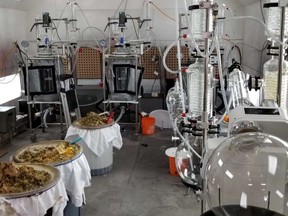In the first half of 2023, violations involving opioids in Calgary were up 314 per cent over the average

Article content
In another reflection of the unrelenting opioid crisis, city police say the number of incidents they’ve dealt with involving the drugs has more tripled in 2023 compared to recent years.
In the first half of 2023, incidents where opioids were considered the most serious violation numbered 207, up 314 per cent over the average for the previous five years and more than double for that time period in 2022.
Advertisement 2
Article content
Article content
The rising numbers point to both an increased police focus and a greater amount of illicit drugs on the street as traffickers cash in on a lucrative trade, said Insp. Jeff Pennoyer, who commands the CPS criminal networks section.
“We’ve obviously seen more of a dedicated look at opioids given all the health and public safety issues,” he said.
“It’s significantly higher and much more prevalent than it was in 2018 . . . There’s money to be made by continually trafficking in these dangerous substances.”
That tends to involve organized crime, contributing to shootings in the city as offenders battle over the profitable trade, said Pennoyer.
So far this year, CPS has made 2,500 fentanyl seizures, compared with 2,100 involving methamphetamine.
And while opioid incidents have been dramatically trending up, those of meth — as with almost all other substance categories — have actually dropped slightly in recent years.
Cannabis, which was legalized for recreational use in 2018 but still contains some legal restrictions, has been all but dropped by police as they turn their attention to harder drugs, said Pennoyer.
Article content
Advertisement 3
Article content
“We’d always focused on harder substances but we do not focus on cannabis at all,” he said.
“That’s where it needs to be, it does more community harm.”
Those policing numbers dovetail with an opioid epidemic that continues to ravage Alberta.
Through eight months of 2023, Alberta and Calgary are experiencing the worst drug poisoning death rates on record and are on track for their deadliest year in history, according to new provincial data.
Related Stories
The numbers come amid a push from UCP government members to end public funding for supervised consumption sites.
Data published last month by the province showed an additional 147 people died of toxic drug overdoses in August, making it the province’s third-deadliest year to date. The province has already recorded 1,262 deaths in 2023 to opioids.
Calgary’s death rate is also significantly higher than the provincial rate, reaching 47.3 people per 100,00 through the first eight months of this year.
Advertisement 4
Article content
The opioid plague has also kept Alberta RCMP busy, with Mounties reporting a 100 per cent increase in overdose responses from January to November compared to all of last year and a 24 per cent hike in Naloxone deployment.

Those battling the criminal end of the crisis are alarmed by a severity not seen from other drugs, said Pennoyer.
“It’s like nothing we’ve experienced before, this opioid epidemic — we are motivated to save the citizens of Calgary from this,” said the CPS inspector, adding there’s no way to enforce the problem away.
“I don’t know if the law enforcement part of it is the be-all and end-all of that process.”
Local, larger-scale production of fentanyl doesn’t appear to play a significant role in the drug’s prevalence, said Pennoyer, but it’s hardly unheard of.
In July 2021, police busted a “superlab” that had been operating at Aldersyde, 45 kilometres southeast of Calgary, seizing 31 kilograms of fentanyl and 7,600 kilograms of chemicals that produced the synthetic opioid with a street value of about $300 million, say police.
Smaller production sites inside the city have also been dismantled.
Advertisement 5
Article content
But importation from beyond Canada’s borders and ordering through the so-called dark web, or a special server that hides identities, are more common sources, said Pennoyer.
And the toxicity of drugs confiscated by police varies, he said.
“We’ve made relatively pure seizures as well as fentanyl (cut) with a variety of different substances,” said Pennoyer.
The increasing toxicity of fentanyl cut with dangerous additives such as benzodiazepine, which extend the drug’s high, is a growing threat, said addictions specialist Dr. Monty Ghosh.
“It’s very similar to what people used to feel from heroin. The problem is, it increases your risk of having a drug poisoning event or overdose,” said Ghosh, who works with vulnerable populations.
Those additives can make it more difficult to reverse overdoses, as well as complicating recovery as users go through benzodiazepine withdrawal, he said.
“We’re definitely needing to use more Naloxone, especially with benzos and carfentanil, which is 50 times more potent (than fentanyl),” said Ghosh.
“Things are definitely worse now than ever before and it’s not going to get any better.”
Advertisement 6
Article content
Most of the fentanyl flowing into Calgary comes through the west coast and has grown to an “absolute flood,” said Mount Royal University criminologist Doug King.
The scourge has led some desperate users to feed their addictions by targeting rural areas not as heavily policed as Alberta’s cities, he said.
“They’re typically rural areas within 50 kilometres of metropolitan areas. It just runs down the QE2 and it’s thefts, property-related crime,” said King.
He said the big money and organized crime involved in trafficking opioids and the drug’s powerful sway over their users means the trade will never be snuffed out.

“The reality is, we’ll never get rid of it, we’ll have to deal with it long-term and those people with opioid disorder,” said King.
The CPS’s Pennoyer said one of the barriers to a more effective crackdown is the difficulty in holding traffickers to account for customers who died from their toxic products.
No such convictions have been obtained in Calgary, he said.
“The standard for charging someone with manslaughter or negligence causing death is significant, and meeting that threshold is difficult to attain,” said Pennoyer.
Advertisement 7
Article content
“It’s something I personally struggle with and would like to find a way to do that.”
Earlier this year, the B.C. government launched a pilot project of decriminalizing possession of small amounts of illicit drugs following its decision to provide a safer, prescribed supply of opioid alternatives to save lives and undermine the illicit market.
Some studies have shown participants in the safer supply program that includes opioids, cocaine and methamphetamine have benefited.
Pennoyer notes Alberta’s chiefs of police believe it’s premature to get on the decriminalization bandwagon, favouring instead a current comprehensive approach that includes treatment.
“Individual initiatives without a co-ordinated plan is not the best plan,” he said.
Addictions specialist Ghosh also urged caution about distributing a safer supply, saying there’s a risk of those drugs being diverted into the illicit market.
“There is much concern around unintended consequences of safe supply and we would need to have those minimized,” he said.
“Ideally, safe supply would be partnered with access to wellness supports, including treatment and recovery-oriented options.”
Article content
'Absolute flood': Opioids become more lethal — and more common — on Calgary streets - Calgary Herald
Read More



Comments